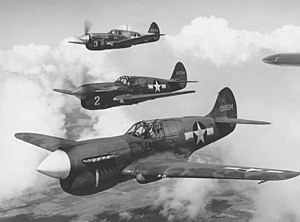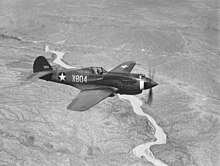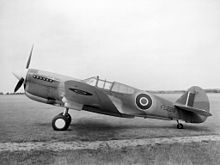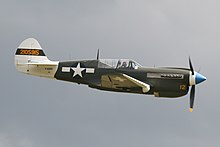Curtiss P-40
| Curtiss P-40 Warhawk
Tomahawk / Kittyhawk |
|
|---|---|
 P-40E from a USAAF training unit at Randolph Field, San Antonio, Texas; in front a machine with a short fuselage tail |
|
| Type: | Fighter plane |
| Design country: | |
| Manufacturer: | |
| First flight: |
October 14, 1938 |
| Commissioning: |
1940 |
| Production time: |
1939 to 1944 |
| Number of pieces: |
13,738 |
The Curtiss P-40 Warhawk (in German about war ax or war falcon ) is an American fighter aircraft of the Second World War . The Warhawk developed by Curtiss-Wright was the standard fighter aircraft of the United States Army Air Forces (USAAF) during the Japanese attack on Pearl Harbor in December 1941 and was used until the end of the Pacific War in early September 1945, supplemented from 1942 by other single-engine models such as P-47 , P-51 and F4U . P-40s were also used in the Mediterranean theater of war .
The P-40s delivered to the British Royal Air Force (RAF), the armed forces of the Commonwealth and the Air Force of the Soviet Union were designated as Tomahawk and Kittyhawk (from version P-40D). All 13,738 P-40s were built by the Curtiss-Wright parent plant in Buffalo in the US state of New York until production ended in November 1944.
description
The single-engine, single - seat low - wing aircraft was developed by the Curtiss-Wright Co. from the Curtiss P-36 , which was driven by an air-cooled radial engine . The choice for the drive of the new P-40 fell on the liquid-cooled V-engine Allison V-1710 . The first flight took place in 1938, series production from 1939 to 1944.
The RAF took over a number of the Curtiss fighters originally ordered for the French Armée de l'air as Tomahawk . Since this could not compete with the Messerschmitt Bf 109 of the German Air Force due to its inadequate performance at altitudes above 4,500 meters , it was used in North Africa, where it proved to be a useful fighter and fighter-bomber at low to medium altitude thanks to its good maneuverability .
Under the lending and leasing law , the Soviet Union received 2,631 machines.
The irregular American Volunteer Group ( Flying Tigers ) fighting for the Republic of China were also equipped with P-40 fighters. In contrast to Europe, the P-40 in China was superior to the enemy fighters in its flight performance, and the Flying Tigers were able to use the P-40 to take on the Nakajima Ki- fighter type predominantly used by the Japanese (there were Imperial Japanese Army Air Forces and Imperial Japanese Navy Air Forces ). 43 "Hayabusa", but above all the single- and twin-engine bombers of the Japanese.

The USAAF's regular fighter squadrons deployed in the Pacific theater of war , which in addition to the Ki-43 were mainly attacked by the Mitsubishi A6M "Zero", had more difficulties in the first few months than the Flying Tigers in finding the weaknesses of the agile Japanese fighters to exploit in aerial combat .
Despite its overall mediocre performance, the P-40 was manufactured in large numbers and used as a fighter-bomber in all theaters of war. Although it was equipped with ever more powerful engines, its flight performance remained behind that of other contemporary fighters. The variants powered by Allison engines could never increase their weak performance at medium and high altitudes due to the single-stage input loader , especially since the combination of large propellers and high-speed propeller shafts led to considerable efficiency losses at these altitudes.
The P-40F and P-40L variants, powered by Rolls-Royce-Merlin engines fitted with two- speed turbochargers with a slightly more favorable gear ratio of the propeller shaft, had the best high-altitude performance of all P-40s, but they too could not match the performance of the Bf 109F or that the newer variants of the Bf 109 or even the Focke-Wulf Fw 190 .
production
Approval of the P-40 by the USAAF:
| year | 1940 | 1941 | 1942 | 1943 | 1944 | TOTAL |
|---|---|---|---|---|---|---|
| P-40 | 778 | 2,246 | 4,454 | 4,258 | 2.002 | 13,738 |
The RAF received the following aircraft:
| Surname | variant | number | comment |
|---|---|---|---|
| tomahawk | Mk I | 140 | |
| Mk IIA | 110 | ||
| Mk IIB | 830 | 100 more went to the Flying Tigers in China | |
| Kittyhawk | Mk I | 560 | |
| Mk IA | 432 | 1,500 were ordered | |
| Mk II | 250 | 79 of these went to France | |
| Mk III | 603 | 1 of them went to France and 170 to the USSR | |
| Mk IV | 586 | 130 of them went to the USSR | |
| total | 3,511 | 3,131 of them to the RAF |
variants
- XP-40
- Prototype, a converted Curtiss P-36 with an Allison V-1710 -V engine, first flight on October 14, 1938
- P-40 (Tomahawk I)
- Allison V-1710-33, two 7.62mm machine guns above the engine, four in the wings; 200 built for the USAAF, 140 for the RAF
- P-40B (Tomahawk IIA)
- Allison V-1710-33 engine; 131 built for the USAAF, 110 for the RAF
- P-40C (Tomahawk IIB)
- Allison V-1710-33 engine; 193 built for the USAAF, 960 for the RAF (100 of which were delivered to the American Volunteer Group )
- P-40D (Kittyhawk I)
- Allison V-1710-39; elongated fuselage nose, six 12.7 mm Browning machine guns in the wings; 22 built for the USAAF, 560 for the RAF
- P-40E (Kittyhawk IA)
- Allison V-1710-39; elongated fuselage bow, built 2320 (of which 1500 as P-40E-1 / Kittyhawk IA)
- P-40F (Kittyhawk II)
- Packard Merlin V-1650-1 (licensed version of the Rolls-Royce Merlin XX ); 1311 built (150 of them for the RAF)
- RP-40G
- Allison V-1710-33 reconnaissance version not deployed
- P-40J
- (only project, engine with turbocharger , abandoned)
- P-40K (Kittyhawk III)
- Allison V-1710-73 (F4R); extended rear fuselage, 1300 built (192 to the RAF, 42 to the RAAF , 23 to the RNZAF , 9 to the RCAF and 25 to Brazil )
- P-40L
- Packard Merlin V-1650-1, lightweight version; extended rear fuselage, built 700
- P-40M (Kittyhawk III)
- Allison V-1710-81; extended rear fuselage, 600 built (including 264 to the RAF, 168 to the RAAF, 34 to the RNZAF and 19 to Brazil)
- P-40N (Kittyhawk IV)
- Allison V-1710-81, lightweight version, extended rear fuselage, 5219 built (approx. 1000 delivered to the USSR , 468 to the RAAF, 456 to the RAF)
- P-40R
- 300 P-40F / L converted to Allison V-1710-81
- XP-40Q
- 2 prototypes, Allison V-1710-121; Radiator under the center of the fuselage, full-view hood
- XP-46
- 2 prototypes; modified P-40C with Allison-V-1710-39 engine, abandoned in favor of the P-40D
- XP-53
- Model 88, projected further development of the XP-46, abandoned
- XP-60, YP-60
- Models 90 and 95, modified drafts of the P-40D, only prototypes, high-volume orders canceled again. Later some more experimental designs
Technical specifications
| Parameter | Curtiss P-40N data |
|---|---|
| crew | 1 |
| length | 10.19 m |
| span | 11.40 m |
| height | 3.76 m |
| Empty mass | 2815 kg |
| Max. Takeoff mass | 3780 kg |
| Top speed | 560 km / h at an altitude of 4940 m |
| Service ceiling | 9450 m |
| Range | 1200 km |
| Engine | a V12 engine Allison V-1710-99 with 895 kW (1217 hp) |
| Armament | six Browning -MG AN / M2 , Cal. .50 (12.7 mm), up to three 227 kg bombs |
See also
Web links
Individual evidence
- ↑ Training unit in San Antonio, Texas ( page no longer available , search in web archives ) Info: The link was automatically marked as defective. Please check the link according to the instructions and then remove this notice.
- ↑ Statistical Digest of the USAF 1946. pp. 100 ff.
- ↑ KJ Meekcombs: The British Air Commission and Lend-Lease. Trowbridge 2009, p. 108 ff.
- ^ A b Peter M. Bowers : Curtiss Aircraft 1907-1947. Putnam, London 1979, ISBN 0-370-10029-8 .
- ^ Riccardo Niccoli: Airplanes. The main types of aircraft in the world . Kaiser, Klagenfurt 2000, ISBN 3-7043-2188-5 , p. 65 .






